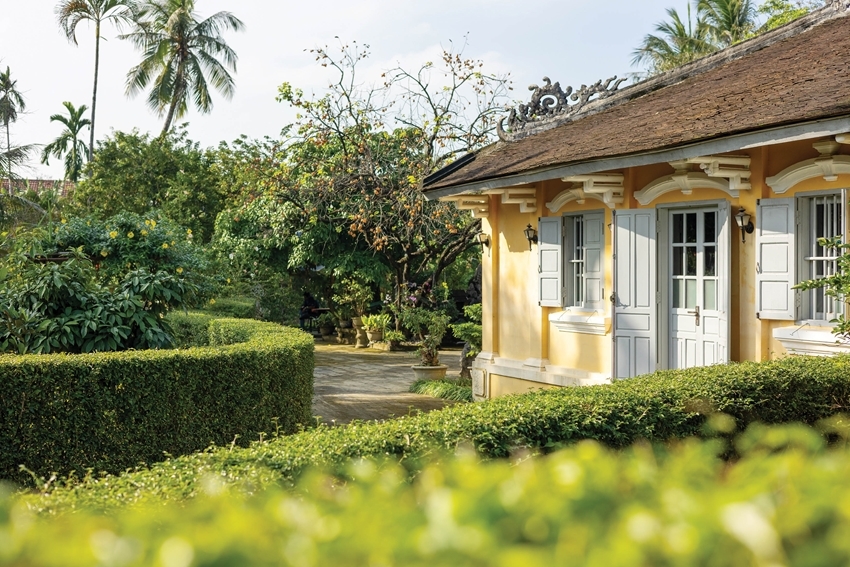 |
| The green hedgerows of Hue garden house. Photo: Phan Trung |
Last September, during a business trip to Dong Nai, I had the opportunity to visit my aunt's house in Tan Lap hamlet, Phuoc Tan commune, Bien Hoa city, after her more than 70 years of resettlement here with her husband. The Southeast region of Vietnam is famous for its red soil. However, the semi-mountainous terrain where her family lives has black soil, suitable only for planting jackfruit trees, star apples, and vegetables such as chili, bitter melon, cucumber, etc. Interestingly, a hedgerow of wild tea trees is trimmed in a straight shape in front of my aunt's yard.
My aunt's youngest brother, who currently inherits the garden and house of my aunt and uncle, said: “These wild tea trees were brought from Hue during my mother's first return to the hometown after the reunification. Now that my mother has passed away, we still take care of them to remember her hometown...”
The wild tea hedgerow is closely attached to the people of Hue and followed people to settle down, apart from Dong Nai, in many gardens in Binh Phuoc, Binh Duong, and the Central Highlands provinces. Therefore, many people say it is easy to recognize Hue families in a faraway land by their wild tea hedgerows.
Wild tea hedgerows are everywhere in Hue, from palaces and monuments to people's gardens. The wild tea not only is used as a hedgerow to create a landscape for the house but also has a very good effect of stopping bleeding. In my countryside childhood memories, whenever I played wild, and my skin was cut and bleeding, I often chewed the wild tea leaves and applied them to cure them. It is also said that it has the effect of being an anthelmintic, expectorant, emesis, diuretic...
However, wild tea trees that function as hedgerows are still the most valuable. Looming in those green hedgerows are trees of osmanthus, camellia, longan, lychee, mangosteen, and thanh tra (Hue pomelo). Together with these famous tree species of Hue, it creates an intimate and elegant picture. Not only taking care of the trees in the garden, Hue people are also conscious of preserving the trees in the community. For example, the over 300-year-old ichytree forest in Sieu Quan village, Phong Binh commune (Phong Dien), is locally protected with a village code. Other ancient trees are scattered in communal houses, pagodas, riverside, and paddyfields. Many are certified as heritage trees...
The exciting thing is that some ordinary trees have suddenly become famous, like the sandbox tree in the fields of Ha Cang village, Quang Phu commune (Quang Dien). Since being chosen by director Victor Vu as a scene for "Dreamy Eyes" - a film adapted from the long story of the same name by the writer Nguyen Nhat Anh, this tree has suddenly become famous. It was renamed the "lonely" tree, the "Dream Eyes" tree, and attracted many tourists, especially young people, to “check-in” and take photos.
It's quite funny when many tourists looking for the "lonely" tree often confuse it with the sandbox tree located in the Von field in Phu Le village, about a kilometer away, which is equally lonely and green. The only difference is that the road to the "lonely" tree of the "Dreamy Eyes" movie set is straight, while the road to the tree in the Von field is bow-shaped. In addition, there is an earthen mound opposite the Von field.
Legend has it that in the past, a group of people "parachuted" to the mound from somewhere to build houses. They were engaged in theft and vandalism, and the authorities could not control them. A geologist built this bow-shaped dam with an arrow pointing into the mound. After only a few years, the families on the earthen mound could not live and left the area... The truth is unclear, but that earthen mound still has traces of people living there. The bow-shaped dam still exists, and the bamboo tree is still there. The sandbox tree is still green and provides shade for local farmers in their rest...
When gathered and launched, the consciousness of green becomes a movement and forms famous green buildings. More than 30 years ago, from the campaign of all people uniting to build cultural life in residential areas, the authorities of Dien Hoa commune (Phong Dien district) integrated and mobilized people's strength to carry out the concreting of the rural traffic system.
Among them, the most famous is the "Happiness Road". Each newly married couple voluntarily contributes to building a main road in the commune center. Up to now, the "Happiness Road" continues its expansion, thanks to the contributions of thousands of local couples. This becomes a symbol and pride of Dien Hoa people with the spacious concrete road and stone benches along the rows of green coconut trees...
In many other localities, many good models in road construction and tree planting also exist. Since the "Green Sunday" movement was launched with the active response and engagement of the government, veterans' association, women's union, youth union..., many green routes and bright flower streets have been remarkably formed. Landscapes from urban to rural areas are covered with new colors and change daily.